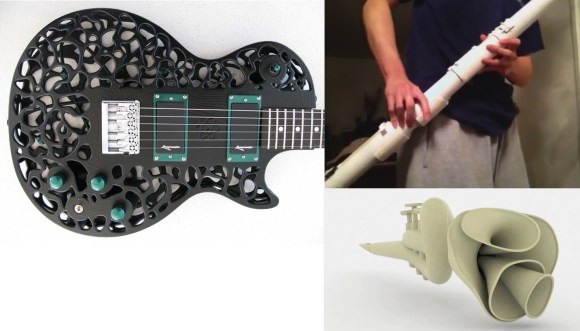
We just stumbled upon a great repository of all musical things that are 3D printed. It’s a wiki dedicated to sharing and recording these 3D printed instruments to help encourage further ideas and projects.
The people maintaining the site find different projects and share them, adding descriptions which would go great into a database search. They explain the type of instrument, it’s history, a picture or video of it and the method of manufacture used to create, whether it be traditional 3D printing, laser cutting, or another process.
Some of our favorites include the 3D printed guitar bodies, the strange looking multi-horn trumpet (that’s the weird one, bottom right) by the MIT Media Lab, and of course the humongous bass recorder (top right).
Stick around after the break for a few videos of these different unconventional, unorthodox instruments!
Or this ridiculously cool minimalist 3D printed guitar…















In an electric guitar, the body material has little to no influence on the sound (comes from strings & pickups). It has an influence on the comfort to carry it, though, as a completely hollow body has to be much bigger to counter the weight of the neck and head, otherwise it will be uncomfortable to play.
The situation is different for accoustic instruments (like trumpets or violins), where the material actually resonates the vibrations. A material with the wrong structure will certainly change the accoustic properties of the instrument (for good or for worse).
With this in mind, it is safe to say: they didn’t 3D print a “Stradivarius”, but rather something that looks similar to a classical violin, but certainly does not sound like one.
Cheap plastic violins are already on the market, BTW, and they all look like Stradivarii, but never sound like one.
http://skeptoid.com/episodes/4328
Really interesting link. Reminds me of doing speaker comparisons. At some point it’s just hard to discern a difference. The 20m test of six violins in multiple categories was probably gruelling.
Thanks, great article! And beeing a bit of a hobbyist luthier myself, I’d like to point out that the same is true for guitars.
But even if modern master-built instruments are equal or even superiour to the “classics”, it is still a long shot to claim that a 3D-printed instrument could match it.
Article is both true and pretty damn interesting, but it deals with violins made with the same materials just by different people. I’m fairly sure that there will be a difference in the sound of a violin made out of plastic over one made out of wood, because as agtrier says the resonance of the material is part of what creates the sound.
Whether it would be particularly noticeable, or even whether the differences would degrade the sound, is another matter. Also there’s a bit of a difference between people in a factory duplicating the basic functionality of a violin in plastic and a luthier working to create what they already do using a different material. The latter is likely to put a lot more work into getting a good result, and as such their designs would probably sound a lot better than the cheap plastic ones on Amazon
The body material of a solid body guitar or bass does have quite an influence on the sound. Not because of shape but because of other factors such as the density of the material which affects how the strings vibrate- harmonics, sustain (Spinal Tap reference!) and so on.
actually this article sounds like a translation of a blog post of mine (about 3d printed musical instruments): http://bit.ly/1e0dd0t
btw acoustic instruments can be 3d printed as well, and it doesn’t mead that the sound quality goes wrong. Just think about the plastic/carbon fibre guitars of Ovation played by the best musicians all over the world…
Well, just Ovation is a really bad example, as what they are famous for are really (Piezo-) electrical instruments in the shape of accoustic guitars. The reason they are played (on stage) by famous musicans is really that they don’t feed back (as a real accoustic guitar would do) and can be easily connected to the PA system (which is always clumsy for accoustic guitars), but certainly not for their sound qualities.
Sound engineers always hated them. They sound like plastic boxes…. so do most small speakers (Bose!!) but people seem to find that acceptable.
d
Here is a Kickstarter running right now to create a really great sounding set of 3D printable bagpipes and to expand the capabilities of traditional bagpipes by using 3D printing. https://www.kickstarter.com/projects/1831738419/dreaming-pipes-developing-small-bagpipes-using-3d?ref=live
Well yes, but *any* technology is capable of being turned to evil really (says the scotsman who quite enjoys pipe music)
So where can I get an Octaventral Heebiephone printed up?